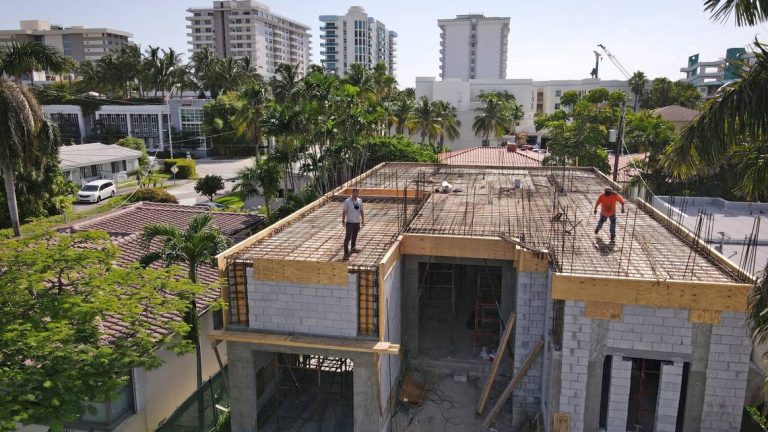Above: Real estate agent and single-family home developer Jeff Rose, who lives with his family in Surfside, has built several homes in the coastal community in 2021.
emichot@miamiherald.com
Thousands of home builders from around the world will flock to Las Vegas this week for their annual convention: the International Builders’ Show. At IBS, design and construction professionals will preview hundreds of sinks, toilets, cabinets and what-have-you, as well as entire demo homes showcasing the latest trends in design and the hottest new products.
One exhibition venue that always generates a lot of interest is the much-heralded New American Home. But this year, two of the most interesting display homes won’t be seen by convention attendees — at least not in person. One of them, the Virtual Concept Home from the Livabl SEO platform, only exists virtually, as its name suggests. Another, called VISION House, was built in a Milwaukee suburb.
Livabl’s home concept debuted at the Pacific Coast Regional Builders Conference last year. But Las Vegas is where IBS will be played the most, albeit on computer screens. Whether builders will be impressed enough to adopt his ideas remains to be seen, but it is being billed as “the house that grows with you”.
The basic design is approximately 2,300 square feet, but it can be built slightly smaller or larger. It may have three or four bedrooms and three or four bathrooms. The plan calls for a covered outdoor lounge and public and private courtyards. With four flexible spaces, the home can adapt to the needs of different life stages, including young families, empty nesters and multi-generational households.
“It’s not a futuristic, over-the-top house; it’s a home for today’s consumers, taking into account the changes of recent years and the way people live and use their homes today,” says Jeff Meyers, CEO of Zonda, the parent company of Livabl.
Conference visitors can virtually “walk around” the venue and switch between layouts, materials, finishes and color combinations. You can experience it yourself at 2024concepthome.com.
“I call the house a chameleon because it can truly adapt based on what the user needs at any given moment,” says Dave Kosco of Bassenian Lagoni, the California architectural firm that led the design team. collaborative from home.
The space next to the main living area, for example, can be used as an office, playroom or bedroom. The courtyard offers three different outdoor living options. Even at its smallest size, the courtyard offers space for outdoor dining, a spa with a pergola, lounge areas, and water and fire features.
While a two-car garage is almost a given these days, the Livabl design requires a single-car enclosure plus an adjacent carport. As a parking space, the carport can be separated from the garage by a “ghost screen”, but it can also function as an extension of the private courtyard in front of the house. (An optional elevator can be added in the garage to accommodate two cars, if necessary.)
Entering the house from the car park there is a space which can be used as a cloakroom or office with a built in desk. Another flexible room can be a child’s bedroom or living room, or the space can contain an optional staircase to the second floor.
Meanwhile, with the VISION House in Sussex, Wisconsin, Green Builder Media and its partners aim to show how homes can be built to optimize performance, durability, resilience and health, all at affordable prices. This particular storefront was built by Tim O’Brien Homes, a company long committed to sustainable construction. When the house opened to the public last September, visitors were particularly excited about the solar panels and batteries for energy storage.
“They loved the idea of having their own mini-utility company using the energy they produce,” O’Brien said. With the exception of the gas boiler, which only comes into play in bad weather, the house runs solely on electricity. Solar panels run the system, but batteries and an inverter provide backup electricity in the event of an outage. The system charges during off-peak hours and uses what is stored in the batteries at peak times, saving on electricity rates.
The VISION House has no special design features like Livabl’s house, except perhaps its open floor plan with “‘de-stress’ areas” and “phone charging stations there where they should be,” according to a press release.
But it has dozens of other futuristic features: durable polyester carpet made from 100 percent plastic; PVC-free laminated wood veneer flooring; shower tiles made from 98% recycled materials; Touch-controlled kitchen faucets with three different settings, including Boost mode, which increases flow by 30%. Garage doors are made from 76% recycled steel. All walls, ceilings and woodwork are covered with paint composed of low volatile organic compounds. The windows are high performance Energy Star rated units. And the cabinet shelves can be adjusted as desired, without any tools.
Other versions of the VISION House have been erected across the country to educate builders and consumers on how to build a more efficient home. See details at greenbuildermedia.com/about-vision-house.
Sure, these homes are aesthetically pleasing, but according to Sara Gutterman, co-founder and CEO of Green Builder, “unless we build next-generation homes that are net-zero, electrified, resilient, healthy, connected, gas-powered solar powered and, in some cases, prefabricated, all we do is erect structures for someone to repair, repair, upgrade or demolish.
Lew Sichelman has been involved in real estate for over 50 years. He is a regular contributor to numerous shelter magazines and housing and housing finance industry publications. Readers can contact him at lsichelman@aol.com.

